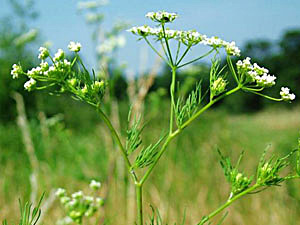
natural herbs
Turnip-Rooted Chervil
Chaerophyllum bulbosum

Herb: Turnip-Rooted Chervil
Latin name: Chaerophyllum bulbosum
Family: Umbelliferae
Edible parts of Turnip-Rooted Chervil:
Root - raw or cooked. The raw root is rather tough, but has a nice, aromatic, starchy flavour. When cooked it becomes floury and sweet with a peculiar flavour that is excellent and unlike any other vegetable. Peeling the roots ruins the flavour. The root is about the size of a small carrot. It can be harvested when the foliage dies down, usually in July/August from an autumn sowing, and stored like potatoes for later use. It is best harvested as required. The roots contain about 20% starch and 4% protein. Young stems - raw or cooked. Some caution is advised, see notes at the top of the sheet.Description of the plant:

Plant:
Biennial
Height:
120 cm(4 feet)
Habitat of the herb:
Fallow fields and water meadows from 1000 - 2100 metres in Turkey.Propagation of Turnip-Rooted Chervil:
Seed - best sown in the autumn in situ. The seed has a very short viability or, according to another report, the seed becomes dormant if allowed to dry out and will not germinate for a year. If stored for a spring sowing it should be kept in damp sand in a cold but frost-free place and then sown in situ in March. Another alternative is to sow the seed in the autumn in a seed tray in a cold frame and then to sow the seed, soil and all, in early April in situ.Cultivation of the herb:
Fallow fields and water meadows from 1000 - 2100 metres in Turkey.Medicinal use of Turnip-Rooted Chervil:
None knownKnown hazards of Chaerophyllum bulbosum:
One report suggests that the leaves and roots are poisonous. The same report says that this plant is cultivated for its edible root! The root is unlikely to be poisonous.Plant information taken from the Plants For A Future.
